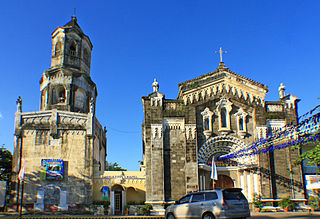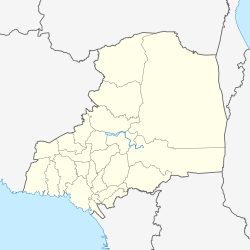
Balagtas, officially the Municipality of Balagtas, is a 1st class municipality in the province of Bulacan, Philippines. According to the 2020 census, it has a population of 77,018 people. The municipality is 30 kilometers (19 mi) from Manila and is 15 kilometers (9.3 mi) from Malolos City.

The Our Lady of Remedies Parish, also known as Malate Church, is a Roman Catholic parish church in the district of Malate in the city of Manila, Philippines. This Mexican Baroque-style church is overlooking Plaza Rajah Sulayman and, ultimately, Manila Bay. The church is dedicated to Nuestra Señora de los Remedios, the patroness of childbirth. A revered statue of the Virgin Mary in her role as Our Lady of Remedies was brought from Spain in 1624 and stands at the altar.

The Diocesan Shrine and Parish of Saint Augustine, commonly known as Baliwag Church, is a Roman Catholic church located in Plaza Naning at the poblacion of Baliwag, in Bulacan province, Philippines. The church is a parish church of the Diocese of Malolos, which is a suffragan of the Archdiocese of Manila.

San Juan de Dios Parish Church, commonly known as San Rafael Church, is an 18th-century Roman Catholic church situated in Brgy. Poblacion, in San Rafael, Bulacan, Philippines. It is under the jurisdiction of the Diocese of Malolos. Its titular patron is St. John of God; Saint Raphael, archangel, is the secondary patron saint. The church was the site of the Battle of San Rafael, wherein hundreds of retreating Filipino soldiers and civilians lost their lives during a battle with the Spanish on November 30, 1896. A historical marker by the National Historical Commission of the Philippines was installed in front of the church in 1997 to commemorate the massacre of an estimated 800 Filipinos.

Saint Augustine Parish Church is the only Augustinian Roman Catholic church in Bay, Laguna, in the Philippines. It is under the jurisdiction of the Diocese of San Pablo. The church was first administered by Augustinian friars and later transferred to the Franciscans.

The Diocesan Shrine and Parish of Nuestra Señora de la Asuncion, commonly known as Bulakan Church, is a 19th-century Neo-Byzantine-Romanesque stone church located at Brgy. San Jose, in the Municipality of Bulakan, Bulacan province, Philippines. It is one of the parishes of the Roman Catholic Diocese of Malolos under the Vicariate of the Immaculate Conception. The church was declared Marked Historical Structure of the Philippines in 2007 by the National Historical Institute, the precursor of the National Historical Commission of the Philippines. A historical marker bearing a brief history of the church was installed by the commission.

San Agustin Parish Church, commonly known as Lubao Church, is a 17th-century Neo-classic, Spanish stone and brick Roman Catholic church located at Brgy. San Nicolas 1st, Lubao, Pampanga, Philippines. It is under the jurisdiction of the Archdiocese of San Fernando. In 1952, a historical marker bearing a brief history of the structure was installed on the facade of the church by the Historical Committee of the Philippines, precursor of the National Historical Commission of the Philippines. In 2013, the church has been declared by the National Museum of the Philippines as an Important Cultural Property.

The Immaculate Conception Parish Church, commonly known as Guagua Church, is a 17th-century Baroque church located at Brgy. Plaza Burgos, Guagua, Pampanga, Philippines. Its is under the care of the Immaculate Conception parish of the Roman Catholic Archdiocese of San Fernando. In 1982, a historical marker bearing the brief history of the church was installed on the facade by the church by the National Historical Committee, precursor of the National Historical Commission of the Philippines.

Saint Catherine of Alexandria Parish Church, commonly known as Porac Church, is a 19th-century Baroque Roman Catholic church located at Barangay Poblacion, Porac, Pampanga, Philippines. The parish church is currently under the ecclesiastical province of the Archdiocese of San Fernando.

The San Nicolas de Tolentino Parish Church, commonly known as Macabebe Church, is a 17th-century, Baroque Roman Catholic church located at Barangay Santa Cruz, Macabebe, Pampanga, Philippines. The parish church, under the patronage of Saint Nicholas of Tolentine, is under the Archdiocese of San Fernando.

The Diocesan Shrine and Parish of Saint John the Baptist, also known as the San Juan Bautista Parish Church and commonly known as Calumpit Church, is a 17th-century, Roman Catholic, baroque church located in Calumpit, Bulacan, Philippines. The parish church, under the patronage of Saint John the Baptist, belongs to the Diocese of Malolos under the Vicariate of Saint James the Apostle.

Saint Michael the Archangel Parish Church, commonly known as Masantol Church, is an early 20th-century Renaissance-style Roman Catholic church located at Barangay San Nicolas, Masantol, Pampanga, Philippines. The parish church, under the patronage of Saint Michael the Archangel, is under the Archdiocese of San Fernando.

San Andres Apostol Parish Church, commonly known as Candaba Church, is a 17th-century, Baroque church located at Barangay Pescadores, Candaba, Pampanga, Philippines. The parish church, dedicated to Saint Andrew the Apostle, is under the Roman Catholic Archdiocese of San Fernando.

The Nuestra Señora del Pilar Parish Church, also known as the San Simon Church, is a 19th-century Baroque Roman Catholic church located at Barangay San Juan, San Simon, Pampanga, Philippines. The parish church, under the protection of its patron saints, the Virgin of the Pillar and Saint Peter, is under the Archdiocese of San Fernando.

The Diocesan Shrine and Parish of San Isidro Labrador, commonly known as Pulilan Church, is a 19th-century Baroque Roman Catholic church located at Brgy. Poblacion, Pulilan, Bulacan, Philippines. The parish church, dedicated to Saint Isidore, the Laborer, is under the Diocese of Malolos. The church is popular for being the site where water buffalos are made to kneel as tribute to the feast day of the patron saint. Like the Saint Augustine Parish from the nearby town of Baliuag, the church is also known for featuring one of the longest Holy Week Processions with at least 110 floats.

The Diocesan Shrine and Parish of San Miguel Arcangel, is a 19th-century, Baroque Roman Catholic church located along De Leon St., Brgy. Poblacion, San Miguel, Bulacan, Philippines. The parish church, with Saint Michael, the Archangel as patron saint, is under the jurisdiction of the Diocese of Malolos.

The National Shrine and Parish of Saint Anne, commonly known as Santa Ana Shrine or Hagonoy Church, is an 18th-century, Baroque Roman Catholic church located in Brgy. Santo Niño, Hagonoy, Bulacan, Philippines. The parish church, dedicated to Saint Anne, is under the jurisdiction of the Diocese of Malolos. It was declared a National Shrine in 1991. In 1981, the National Historical Institute, a precursor to the National Historical Commission of the Philippines, installed a marker with a brief history of the church.

The Parish of Saint Lawrence, Deacon and Martyr, also known as San Lorenzo de Roma Parish Church or Balagtas Church, is an 18th-century Baroque Roman Catholic church located at Brgy. Longos, Balagtas, Bulacan, Philippines. The parish church, dedicated to Saint Lawrence, is under the jurisdiction of the Diocese of Malolos.

The Diocesan Shrine and Parish of San Andres, commonly known as Masinloc Church, is an 18th-century Baroque Roman Catholic church located at Brgy. South Poblacion, Masinloc, Zambales, Philippines. The parish church, dedicated to Saint Andrew the Apostle, is under the jurisdiction of the Diocese of Iba. The church structure, a standout among Spanish-era churches in the Central Luzon region for having been built with coral stone instead of adobe stone, was declared a National Cultural Treasure by the National Museum of the Philippines along with 25 other Spanish-era churches in 2001.

San Luis Gonzaga Parish Church, commonly known as San Luis Church, is a 19th-century Baroque Roman Catholic church located at Brgy. Sta. Cruz Poblacion, San Luis, Pampanga, Philippines. The parish church, dedicated to Saint Aloysius Gonzaga, is under the Archdiocese of San Fernando.

























